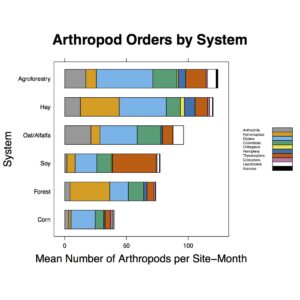2015 Annual Report for ONC15-005
Crop Performance, Pests, and Pollinators in Diverse Agroforestry Systems
Summary
Diverse Agroforestry (DA) systems offer many benefits for farmers and society. Despite the increasing implementation of these systems at relatively large scales, there has been no rigorous on-farm evaluation of the impact of various management strategies on the growth and yield of these systems. The inherent complexity of DA systems makes effective research and outreach difficult, especially when working with a distributed network of farms.
Four Illinois farmers, representing a range of DA management strategies, are conducting intensive research and outreach with Savanna Institute staff and a field research intern to evaluate the growth and yield of DA systems across a range of management strategies, identify baseline pollinator communities, and monitor crop pests/pathogens. Outreach to current and potential DA farmers has been initiated via on-farm field days and a farmer gathering.
Objectives/Performance Targets
RESEARCH
Objective 1: Evaluate the growth and yield of Diverse Agroforestry (DA) systems across a range of management strategies .
Objective 2: Identify baseline pollinator communities present in and interacting with DA systems compared to an adjacent natural area.
Objective 3: Identify & monitor pests and pathogens affecting the novel woody perennial crops included in DA systems
OUTREACH
Objective 1: Document the establishment & growth of DA systems via time-lapse photography
Objective 2: Distribute results via printed materials, online media, and field days
Accomplishments/Milestones
Objective 1: Evaluate the growth and yield of Diverse Agroforestry (DA) systems across a range of management strategies . Each farmer conducted censuses of woody crop plant survival and pest damage. Our field research intern measured woody crop growth at each of the four study farms via stem diameter measurements using a digital caliper. We will repeat these measurements, evaluate crop yield at each farm, and compare results among management strategies in 2016.
Objective 2: Identify baseline pollinator communities present in and interacting with DA systems compared to an adjacent natural area. Our field research intern collected samples monthly between June and September 2015 from four Savanna Institute Case Study Farms in Illinois. To compare the ecological effects of management styles, farms were assigned to low or high categories based on agrochemical and mulch application (input) and maintenance work (labor). Each site includes an agroforestry treatment consisting of rows of fruit and nut trees and shrubs planted into grass or alfalfa hay between 2013 and 2015. Within each farm, transects were also placed in 3-4 agroecosystem types: agroforestry, hay, row crops (corn, soy, or oats and alfalfa), and forest (one site).
To assess the insect communities present in each system, we used a pan trapping transect method. Pan trapping uses small plastic bowls painted blue, white, and yellow to mimic bee-pollinated flowers. Bowls are filled with slightly soapy water to collect insects that enter the traps. While pan traps are targeted at bees, they also capture a range of flower visiting insects in other taxa. As a passive technique, pan trapping minimizes collector bias in bee sampling and requires relatively minimal labor.
Because pan trapping is based on visibility by target organisms, traps must be elevated to the height of surrounding. We achieved this by using tape to attach bowls to sturdy stalks of vegetation. Pan traps were laid in straight transects of 15 bowls, laid 5 m apart.
Insects were identified to order using a dissecting microscope.
Data were analyzed using R. ANOVA analysis was conducted to compare sample abundance between agroecosystems in each taxon. Within the agroforestry system, ANOVA was used to assess the effects of labor and input level for each taxon.
Objective 3: Identify & monitor pests and pathogens affecting the novel woody perennial crops included in DA systems.
Our field research intern worked with farmers to scout crops for several critical pests and pathogens, including, such as Drosophila suzukii and anthracnose. We submitted collected samples to the University of Illinois Extension’s Plant Clinic for pest and pathogen identification.
OUTREACH
Objective 1: Document the establishment & growth of DA systems via time-lapse photography.
We installed time-lapse cameras on four farms that record one photo daily to document the diverse agroforestry systems growth.
Objective 2: Distribute results via printed materials, online media, and field days.
We held a field day at each farm. Field days included tours and presentations by Savanna Institute staff and farmers. We introduced the farming systems and provided an overview of this SARE-supported study. Attendees were provided with light refreshments and opportunities to develop their social networks. Field day announcements and photos following the events were shared on social media.
We will host field days again in 2016 and prepare a bulletin of final results to be shared in print and digital form.
See figures and tables below and attached in higher resolution.
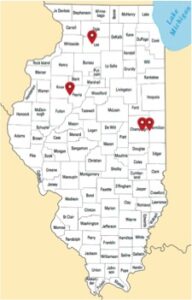
Figure 1. Approximate location of study farms in Illinois
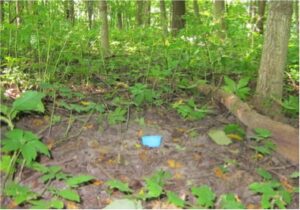
Figure 2. Blue pan trap in a forest system.
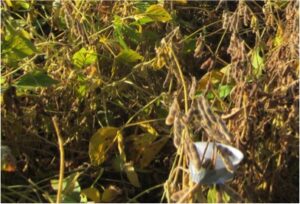
Figure 3. White pan trap in a soybean system showing soybean pan elevated above vegetation by attaching to soy stalk with tape.
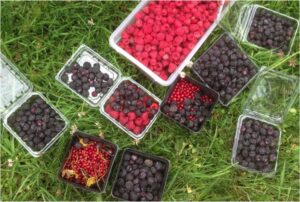
Figure 4. A variety of fruit crops harvested from a diverse agroforestry system in its second year after planting.
Figure 5. Mean abundance of arthropods per transect in each agroecosystem, sorted by order.
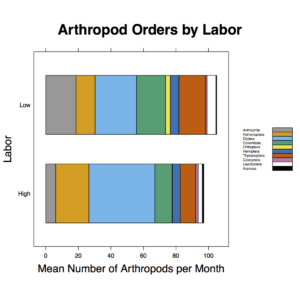 Arthropod_Order_Composition_Labor
Arthropod_Order_Composition_Labor
Figure 6. Mean abundance of arthropods per agroforestry transect in each labor level, by order.
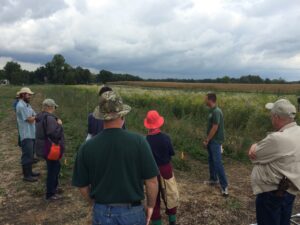
Figure 7. One of four field days held at participating farms.
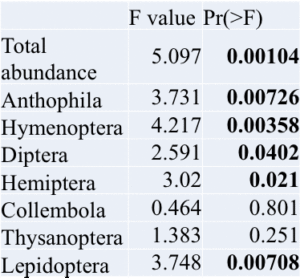
Table 1. ANOVA results for agroecosystem comparisons by order. Bold values are significant at α =0.05.

Table 2. ANOVA results for agroforestry transects comparing two levels of labor for abundant orders. Bold values are significant at α=0.05.
Impacts and Contributions/Outcomes
With only the initial year of results, we have documented arthropod diversity benefits of agroforestry systems. Because these systems are planted in rows among hay alley crops, and the woody crops in this study are still young, their similarity to hay treatments is unsurprising. However, their high average abundance suggests that even early in their life cycle, diverse agroforestry systems host bees and other pollinators better than most row crops while yielding a diverse set of high-value crops compared to hay.
Results also suggest that variations in management approach within agroforestry systems affect insects, particularly bees and flies. Future research will evaluate the relationships between labor and input class, insect abundance, and yield outcomes when more data is available.
At the Savanna Institute annual Farmer Gathering in February 2016, the field research intern and the participating farmers presented to ~50 attendees some of what they have learned so far in this study, contributing to this vibrant community of practice.
We will measure final outcomes and impacts via exit interviews of cooperating farmers.
Collaborators:
Farmer
in Cramer, a tiny place between Trivoli and Farmington in Peoria County.
Elmwood, IL 61529
Office Phone: 3093387876
